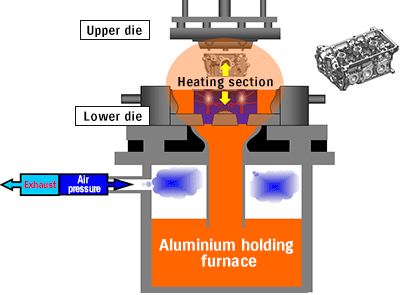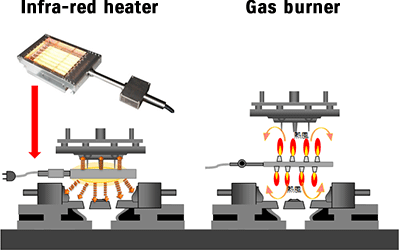Suzuki Sagara Plant Receives the FY2015 Energy Conservation
Grand Prize <Energy Conservation Case Example Category>
- Energy and Labour Conservation through Introduction of Infra-Red Die Heater at the Foundry -
Suzuki Motor Corporation’s Sagara Plant has received the “ANRE (Agency for Natural Resources and Energy) Director-General's Award (co-implementation field)” in the “FY2015 Energy Conservation Grand Prize <Energy Conservation Case Example Category>”.
Since FY1990, Energy Conservation Grand Prize (organized by the Energy Conservation Center, Japan) has been awarding products that excel in energy and electricity conservation, or business operators that have developed business models with high ramification for energy conservation. Energy Conservation Case Example Category was introduced in FY2011, awarding business operators that have made progress by promoting electricity conservation and activities that excel in energy conservation of corporations, plants, offices, etc.
The ANRE Director-General's Award (co-implementation field) was given to Suzuki, Chubu Electric Power, and Metro Denki Kogyo for co-developing an infra-red die heater and introducing it to the engine parts foundry process of the Sagara Plant. Its efforts for realizing significant shortening of heating time and reduction of energy consumption, as well as conserving labour and enhancing safety and productivity of work were highly appraised.
Plus, its expectation for high ramification in expanding the efforts throughout the global Suzuki Group and other business operators was the reason for its selection.
Suzuki is promoting energy conservation by expanding these facilities and efforts in domestic Group companies and overseas plants. Through receiving the award, Suzuki is highly motivated to make efforts for further energy conservation.
The awarding ceremony will take place at the Tokyo Big Sight on 27 January, 2016.
Overview of the ANRE Director-General's Award (co-implementation field)
“Energy and Labour Conservation through Introduction of Infra-Red Die Heater at the Foundry”
| - Business operator: | Administration Group and Foundry Group, Sagara Plant, Suzuki Motor Corporation |
|---|---|
| Shizuoka Branch Office, Chubu Electric Power | |
| Metro Denki Kogyo | |
| - Plant: | Sagara Plant, Suzuki Motor Corporation |
Overview of case example
- - At the die heating process of foundry machine for the engine parts, heating method was switched from conventional gas burner to infra-red die heater.
- - Die heater was invented, developed, and tested by Suzuki, Chubu Electric Power, and Metro Denki Kogyo. By introducing the heater, compared to the conventional gas burner, energy consumption was reduced by 58% (reduced 20.8kl/month in crude oil conversion) and process time needed to heat the die was reduced by 32%, conserving energy and labour, as well as enhancing safety and productivity of work.
Description of main implementation
(1) Efforts for energy and labour conservation
Development and introduction of infra-red die heater
Implemented switching energy of die heating operated before starting low-pressure foundry from LPG to electricity.
Developed infra-red die heater with aim to reduce time needed to heat up to the set temperature and to reduce energy consumption.
(2) Achievement status of energy conservation
1. Effects of introducing infra-red die heater (energy-conserving ability)
By introducing infra-red die heater, compared to the conventional gas burner, energy consumption was reduced by 20.8kl/month in crude oil conversion.
The effects of solution as a result of switching the energy from LPG to electricity are as per below.
- - Consumption of LPG used for die-heating (reduced by 100%)
- - Shortening the time needed to heat up to the set temperature (reduced by 72%)
- - Shortening the process time needed to heat the die (reduced by 32%)
- - Reduction of energy consumption owing to the overshoot control function
- - Since the heater does not glare, light-blocking glasses became unnecessary
2. Labour conservation
For the conventional gas burner, the worker had to monitor randomly. The electric heater automatically controls during and after die-heating, making monitoring by the worker unnecessary.
Erosion inspection of die parts conducted thrice a day and their repairing were abolished. Also, this led to expansion of repairing cycle of die mould wash and reduction of failure trouble of die parts.
3. Optimization of die temperature
By minimizing the space between the die and the heater, and surrounding the die with the heater’s light-emitting part, it enabled to heat the whole die evenly. Also, owing to the automatic control, it enabled to heat the die to high-efficiency temperature distribution, enhancing product efficiency.
4. Enhancing safety of work
After introducing the heater, ignition work itself could be abolished, so there’s no more risk of fire. Also, as a result of establishing rules of heating process, making the heating machine lightweight, and taking handling balance into the design, safety of workers enhanced.
5. Enhancing working environment
Comparison of results for working environment measurement shows that Wet Bulb Globe Temperature improved.
Mechanism of low-pressure foundry machine

Die heater

